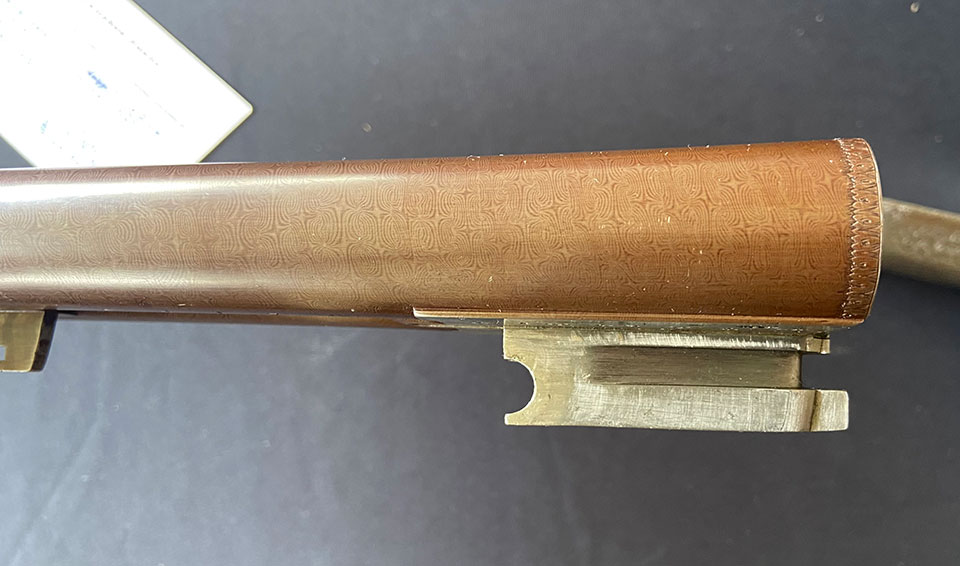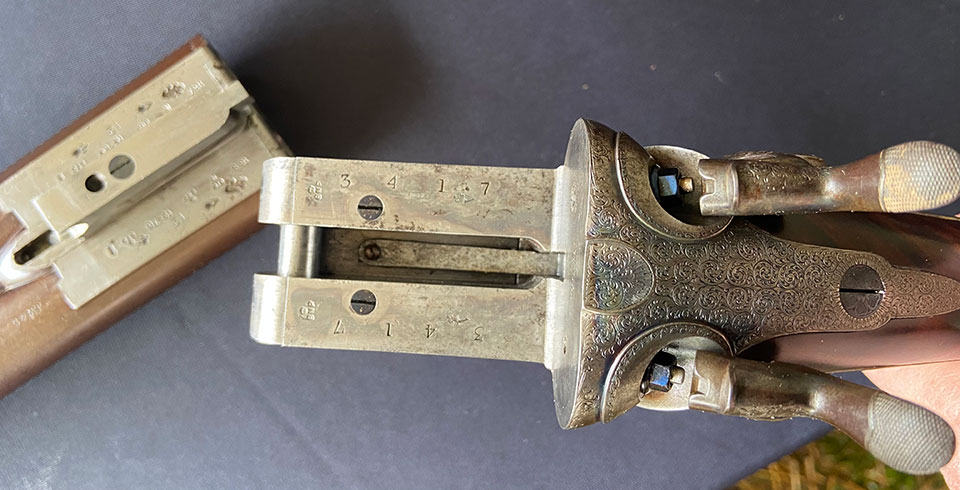I must confess ignorance. Admittedly not for the first time in my life, or this month for that matter, but irritating all the same.
This lovely looking James Woodward hammer gun has a locking and operating mechanism for which I cannot find a patent specification. So, whoever created it, I cannot give credit here, which is a shame.
Outwardly it looks fairly conventional for the late 1870s. The Stanton backlocks rebound, holding the high hammers to what was once thought of as 'half cock' and thereby making cocking a one-step proces, rather than a two-step one. The snap underlever looks much like any other of the period. Upon opening it, one would expect to see a sliding Purdey under-bolt and for the lever to snap shut when the gun is closed.

Neither of those expectations are met when you actually do operate the gun. Closer inspection reveals that it is far from typical, in fact, it may be unique. I have certainly not seen its like before.
The first thing the operator will notice, is that when the gun is snapped shut the lever does not return all the way to the closed position. It requires the user to squeeze it back into the fully locked position. This is easy to do and does not add significant inconvenience to the operation.

Further inspection shows that it does not have a Purdey under-bolt. This gun dates from the mid-1870s, a period when gunmakers were trying to avoid paying their rivals royalties for their designs but facing a customer base which demanded the latest conveniences, of which the 1863 Purdey bolt and the 1865 Scott spindle combination was undoubtedly one.
However, successful though the Purdey/Scott system was, it was by no means universal. The snap under-lever, made popular as far back as 1861 by George Daw, when he introduced Schneider's 'central-fire system' to Britian, continued to be preferred by some makers and, presumably sportsmen. Stephen Grant was selling a lot of side-lever guns at the time and even the inert Jones rotary under-lever (or lever-over-guard' as London makers tended to call it) was still very widely used.

The locking mechanism of this Woodward 12-bore is a pair of bolts. they fit into graduated channnels cut into a single long, lump. This provides a big bearing surface for the bolts to engage with, as they scissor into place when the lever is depressed. Tension is provided by a single V spring.

The gun, being a Woodward, is of best London quality of the day, with fine scroll engraving. 'WOODWARD'S PATENT' is engraved on the breech face but I have not been able to find what that patent refers to in terms of patent year or number. The original, pre-1875 proof marks have been superceded and over-stamped by modern (2015) Birmingham nitro re-proof marks. The chambers are now 70mm and proofed for nitro.
The barrels are 29" (common for Woodward) and fine damascus, with a concave game rib, while the splinter forend is attached by a wedge and escutcheon. The barrels are stamped 'JW&S' for James Woodward & Sons. Neither muzzle is choked and the bores now measure .740" and .736".

The gun was carefully and sympathetically restored by Heritage Guns in 2015 and has again arrived on the market in 2023 at Westley Richards, cased in a re-lined oak & leather case with a Woodward trade label.
Collectors of best hammer guns of this period have a great deal of options as the time was such a hot-bed of invention with great variety of mechanism and style from maker-to maker. Best London guns carry a premium and very good Woodward hammer guns are hard to find.

Such record books for James Woodward & Sons that survive are sparse and not chronologically completed. They provide very little information about the guns or the firm's customers. Woodward is now part of Purdey and Gun Room Manager, Dr. Nick Harlow is about to publish a book about Woodward, with the focus on the over & under design for which the firm is now best known.

Published by Vintage Guns Ltd on




